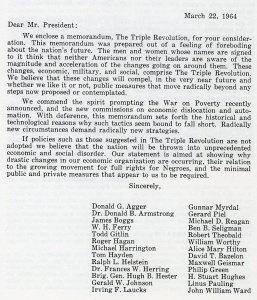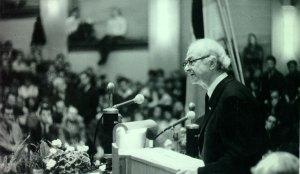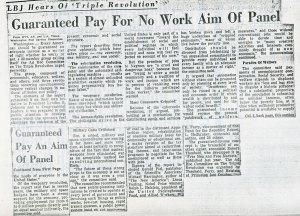
Letter from the Ad Hoc Committee appended to “The Triple Revolution” memorandum, March 22, 1964.
[Part 4 of 6 in a series examining Pauling’s association with the Center for the Study of Democratic Institutions]
Linus Pauling’s connection with the Center for the Study of Democratic Institutions (CSDI) began before he and his wife moved to Santa Barbara. While in Pasadena, Pauling joined a group of social activists that called itself “The Ad Hoc Committee on the Triple Revolution.” Working under the auspices of the CSDI, the Ad Hoc Committee worked together to draft a memorandum addressed to President Lyndon B. Johnson and titled “The Triple Revolution.”
The memorandum was in turn circulated to select individuals and ultimately signed by thirty-five men, a collection of academics, journalists and left activists. Noteworthy among these signatories were James Boggs, an auto worker and author of Pages from a Negro Worker’s Notebook; Todd Gitlin, President of Students for a Democratic Society; retired Brigadier General Hugh B. Hester; Gerard Piel, publisher of Scientific American; Bayard Rustin of the War Resisters League; and socialist leader Norman Thomas. Also included were Linus Pauling and W.H. “Ping” Ferry, vice-president of the CSDI.

Linus Pauling, 1964.
Submitted in March 1964, “The Triple Revolution” opens with a letter to the president in which the Ad Hoc Committee states its concern that Americans and their leaders are “unaware of the magnitude and acceleration of the changes going on around them.” The letter was signed by each of the committee members and was later published in pamphlet form alongside the main text of the “The Triple Revolution” memorandum.
“The Triple Revolution” states that three main socio-economic revolutions were occurring during the 1960s: the Weaponry Revolution, the Cybernation Revolution, and a Human Rights Revolution comprising civil rights movements all around the world. The piece also suggests that all three revolutions were the result of technological development and changes in the economy.
The Weaponry Revolution speaks to one of Linus Pauling’s greatest hopes: the end of war as a means of conflict resolution. In proposing that a weaponry revolution was in place, the memorandum elaborates on the topics of nuclear warfare and disarmament. The pamphlet suggests – as Pauling had often done before – that the threat of such weapons should steer nations to end the use of war altogether in order to avoid the destruction of modern civilization. While acknowledging the degree of difficulty of this undertaking, “The Triple Revolution” nevertheless holds on to the idea of a “warless world,” stating that it is a need acknowledged by most people.
The memorandum also suggests that a Cybernation Revolution was underway, meaning that the use of machines was slowly changing the roles assumed by people in the economy and society. The Ad Hoc Committee was concerned that those without the wealth to purchase or develop machines would be left without the opportunity to earn a living, should the economy switch to a purely machine-based means of production.
The members of the committee also believed that the Cybernation Revolution would cause an unequal distribution of wealth which would eventually lead to an unsustainable national economy. And, indeed, one of the proposals put forth in “The Triple Revolution” is an equal distribution of wealth, carried out as a necessary action to prevent future economic instability. The memorandum encourages the development of an economic system that compensates those who do not own machines and do not have access to the means of production; a concept the document refers to as “the right to an income.” The Ad Hoc Committee believed that groups like African Americans in the early 1960s existed in a social and legal situation that prevented them from owning machines, limiting their opportunities for economic development.
Members of the Ad Hoc Committee believed that, by the 1960s, societies around the world needed to recognize the dignity of each individual. The group likewise believed that the civil rights movement in the United States was only a local manifestation of a world-wide trend to reform political systems such that individuals could not be excluded on account of their race. “The Triple Revolution” thus describes the civil rights movement in the United States existing as part of a broader Human Right Revolution in place at the time.
The document suggests that the U.S. government had the power to lead American society through the changes being ushered in by the triple revolution, primarily by decreasing the amount of resources and attention given to military endeavors and increasing the attention given to those who are at a social disadvantage. The pamphlet concludes by stating that failure to seek solutions to the issues that arise when human labor is replaced by machines would exacerbate social inequality and lead to “misery and chaos.” But so too did it remain hopeful that, given proper leadership, societies could overcome the challenges presented by the changes of the 1960s.

Louisville Courier-Journal, March 23, 1964.
In presenting “The Triple Revolution” to the federal government, the Ad Hoc Committee identified itself as a group of concerned citizens. And though the text made sure to include the government in its suggestions for the future, the document was considered by many to be radically anti-government, and by some to be anti-American. In particular, many who opposed the views presented in “The Triple Revolution” worried about its apparent lack of appreciation for the military, as indicated by the pamphlet’s recommendations that resources used for military efforts be limited. Media pundits were also quick to disparage the idea of a guaranteed income and its implications of creeping socialism.
Two weeks after receiving the document, the White House issued a short response to “The Triple Revolution,” stating that the President had taken measures to address the problems identified in the memorandum. The letter is signed by Assistant Special Counsel to the President Lee C. White, who is remembered for having advised Presidents Kennedy and Johnson on civil rights strategies. For the most part, the response uses general statements and examples as evidence that President Johnson’s “War on Poverty” was considering the issues brought up by the memorandum. It is unclear whether Johnson ever read or even received the document personally.
Despite media opposition to the document and its quick dismissal by the government, other peace activists shared many of the views expressed in “The Triple Revolution.” One group, Women Strike for Peace – an organization in which Ava Helen Pauling was especially active – expressed many of the same views on world affairs when it organized a demonstration outside the Peace Palace at The Hague in 1964. Through their activism and intellectual product, the Ad Hoc Committee and Women Strike for Peace alike were issuing a demand that social inequalities be resolved both for the benefit of individual societies and also as a step toward international peace.
